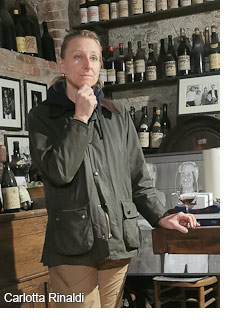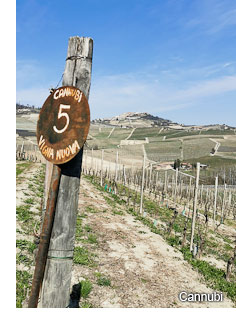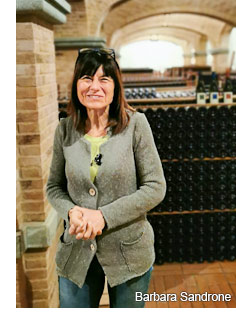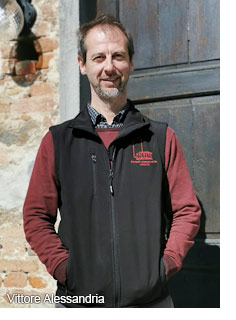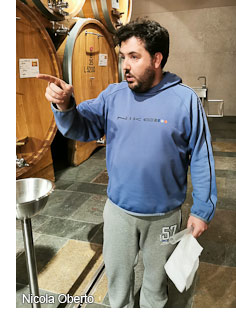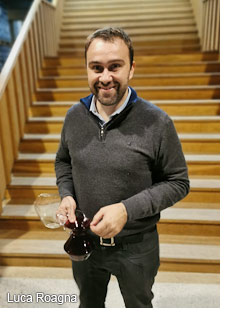2018 Barolo: more roses than tar
Wines with energy and delicate, silky tannins. 2018 Barolos are not by and large tightly coiled wines that will take decades to unfurl, but are energetic and sappy, expressive and aromatic: more roses than tar.
Barolo is a dramatic and special place. It is only 5 miles north to south, east to west, but the steep hills and deeply furrowed valleys of this small region are responsible for many of Italy’s greatest, most sought-after wines. The very best part of our job, and what we most look forward to, are trips to wine regions, visits to cellars and vineyards. That said, we arrived in Barolo last week to taste the 2018s with a certain trepidation. After Antonio Galloni’s shocker of a vintage review, what were we going to find? Galloni admits it is a vintage of hits and misses, but downplays the hits, and suggests you have to go back to the early 1990s to find such bad misses. Perhaps it is because Uncorked producers cluster at the top end, but that just doesn’t reflect what we tasted. As Carlotta Rinaldi told us, ‘2018 was not an easy vintage. But my father would have laughed at the idea it was a bad one. Considering the vintages he worked, he would have said: you have no idea what bad weather is.’
The hardworking vigneron’s vintage
2018 was certainly complicated in the vineyard and demanding for the winemaker, but for skilful and hardworking vignerons, all the potential was there to make beautiful wines.
In June the weather switched. The rain stopped and it turned very hot. Vineyards dried out and grapes ripened quickly. Towards the end of the season, temperatures moderated again. Ripening slowed down, pushing harvest back. That was no bad thing; more hang time means more time for flavour development. Harvest took place under good conditions, and hard-working vignerons were rewarded with clean, healthy fruit going into the winery. Carlotta Rinaldi summarised: ‘it was warm, and the fruit was ripe, but there was still acidity at the end, which is why I love the vintage’.
A place in the sun
Luca Roagna emphasized the importance of site: ‘In a tricky vintage you really see the pedigree of a vineyard’. To take one example, the vineyard of Cannubi is precipitously steep on three out of four compass points. (One supplier we work with took a comic tumble down the south face of Cannubi while expounding on soil types). That steepness is an asset when it comes to drainage, meaning excess moisture will not accumulate, so in a wet year, fungal diseases are less likely to be a problem here.
Tar and roses
I had to laugh at the ‘Tar N’ Roses’ t-shirt hanging in Maria Teresa Mascarello’s office, showing the faces of some classic Barolo winemakers mocked up in the style of a Guns N’ Roses poster. ‘Tar and roses’ is a classic description of Barolo, evoking the contrast between delicate, floral aromas and a grippy, tannic backbone. Yet in 2018, most of the wines we tasted enjoyed fresh, delicate tannins, silky more than grippy. The vintage is more roses than tar.
Once upon a time, a Barolo just meant a wine produced from whichever Nebbiolo vineyards a producer held. But in the 1960s, the first single cru Barolos began to appear, bottles defined and named by the single Barolo vineyard they came from. These represented attempts to create something more special and more singular. Over time, cru bottlings became more widespread, and these days most producers will have both a ‘classic’ (blended) Barolo and one or more cru Barolos in their portfolio.
The more cru bottlings a producer releases, the fewer grapes they will have to make a classic Barolo. A good producer will make sure they have enough good material to make a good classic Barolo as well as their cru bottlings. I was particularly impressed this year, for instance, with the way the Grimaldis handled the balance between their crus and their classic (Camilla).
In the best years, this is an easier balancing act, when all the fruit coming in is top quality. In more challenging vintages a producer needs to think carefully. That might mean dropping one cru to strengthen the classic, or (perhaps more likely) swerving a future riserva release. We spotted some producers who produced good 2018 cru bottlings but whose classic Barolo was weak and weedy. Happily, none of these were producers we habitually list!
Barbera and Dolcetto
It’s not just about the Nebbiolo. Barbera and Dolcetto are two other classic and complementary black grape varieties of the Langhe. Barbera is high in acidity but low in tannin; Dolcetto is tannic but low in acidity. Barbera is often planted on the windy hilltops where other grapes won’t ripen; Dolcetto is often planted at the bottom of the slope where cold and frost will gather. As the fussiest (and highest-value) Piedmontese grape, Nebbiolo gets planted on the best sun-belt sites in the mid-to-top slope. The fact that Barbera and Dolcetto may get planted on second-best sites explains their variation in quality, and their less exalted reputation. Barbera is often put in oak to give it a little more structure; Dolcetto is usually raised in stainless steel to keep a fresh style. We tend to think of these as immediate varieties, not for aging. That could sometimes be a mistake: I have seen bottles of both Barbera and Dolcetto from top producers (Roagna, Rinaldi) benefitting immensely from a few years in the cellar. Producers who treat these varieties with respect are being rewarded with some wonderful, joyful wines.
One thing Barbera and Dolcetto have in common is a susceptibility to the vine disease flavescence dorée. This disease causes leaves to yellow and berries to shrivel and become bitter. It kills young vines and can make old vines uneconomical. Climate change means that the insects that spread it have more of a geographical reach than in the past, and it is becoming a serious problem in the Langhe. There is no cure, and when your wines become afflicted, there is no solution except to replant. Flavescence dorée doesn’t seem to have troubled Nebbiolo very much, though one producer ominously told us they had seen signs that Nebbiolo vines are also becoming affected.
Adapting to change
‘Nobody whose family have been making wine for three generations can be a climate change sceptic’. One producer adamantly summed up something we heard again and again: the climate is getting warmer and producers need to adapt. Thirty years ago, the biggest worry would be ripening grapes before bad autumn weather set in. These days, it’s more likely to be excessive heat and sunburn on the grapes, and it demands a new approach from vineyard managers. Canopy management is very important– there’s less ‘topping’ than before, that is, less cutting away overhanging leaves from the top of the vine. In a hot season, some extra leaves give the most exposed grapes some crucial extra shade. Also, allowing more leaf growth means slower grape ripening (as the energy of the vine is focused elsewhere). That is important – in a hot season, grapes will ripen fast, but slower ripening can lead to better flavour development.
At start of the year, the nets are down, rolled up against the bottom of the vine. They are unfurled from around June, when the danger of summer hailstorms sets in. They may also play a positive role in providing some shade and protecting grapes from sunburn. But not everyone is a fan. Apart from aesthetic considerations, some producers suggested to us there may be a downside for grape quality. The nets may impede air circulation, which will encourage vine disease. There is also the possibility the shiny plastic material they are made of is reflecting heat back onto the vines, overwarming them.
Where Burgundy leads…?There has been a lot of conversation in relation to Burgundy recently about whole bunch. Some Barolo producers also talked about using or experimenting with the technique. Instead of destemming all their grapes (the conventional norm since the post-war invention of mechanical destemmers), a producer may choose to put a proportion of whole bunches (stems and all) into the vat. The technique has pros and cons. It tends to make wines very expressively aromatic, and give them extra lift, which can bring an attractive impression of freshness in a hot year. The technique brings its own distinctive aromatic signature, which some people don’t like. Some will argue that it makes the wine smell of the technique rather than the terroir, diminishing its sense of identity. There are great producers on either side of the debate. Rinaldi and Bartolo Mascarello have a classical approach, destemming everything. At Trediberri, Nicola Oberto is happy to use up to the 30% whole bunch in some vats of his Barolo. In hot vintages, Luca Roagna uses 5-10% whole bunch to bring a little crunchy freshness to his wines; Luca notes that this is below the proportion where the aromatic signature of the technique will be evident.
It is notable that every producer we spoke to who uses a proportion of whole bunch emphasized that this has to be a vintage-responsive technique. Stems ripen more slowly than grapes, and it is not ususual for grapes to be ripe while the stems remain unripe. Unripe stems are better avoided, as they will import a bitter, unpleasant flavour. So the use of whole bunch is best saved for warm vintages when stems are likely to be ripe as well as grapes. Also (at least for now) nobody seems to be experimenting with the very high proportions of stems it is not unusual to find in Burgundy. I have heard it suggested that Nebbiolo might not be as natural a match for the technique as Pinot Noir may be.
And the state of play is…When we visited in March, almost every grower we spoke to was concerned about the current drought. It had snowed once in early December, and there had been a day with a bit of rain in February, but that was it. The roads were dusty, and at the surface, vineyard soils were cracked, clumped and crumbly. But in Luca Roagna’s cellar there is an exposed wall of subsoil, several metres below ground level. It was notable that these subsoils were damp and dripping water. This is the advantage that old vines with deep root systems have; they can reach deep lying water reserves, making them more resilient and less likely to close down in a hot season. In any case, it is still early days; all is still to play for in 2022.
Vintages in perspective
Vintages do not exist in isolation, but are a natural continuation of whatever happened the year before. The rains in early 2018 were very welcome after the 2017 drought. Interestingly, there are a lot of parallels between the 07/08/09/10 and 17/18/19/20 vintages. Like 2017, 2007 was a hot, arid year where drought challenged producers. Like 2018, 2008 saw a year that started cool but finished hot (and 2008s have aged very well). Like 2009s, 2019s are classically tannic wines from a vintage with some summer heat spikes, and like 2010s, 2020s are structured wines for the longer haul.
At the end of the day, vintage affects the character of a wine, but there are many other variables in play too. To give the last word to Nicola Oberto, the best producers are the ones who treat every vintage like it is their first, thinking it through from the ground up, not following a formula that worked last year. These are the great producers who can make great wine whatever the vintage gives them. /NT

